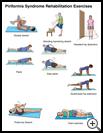
Piriformis Syndrome Exercises
Your healthcare provider may recommend exercises to help you heal. Talk to your healthcare provider or physical therapist about which exercises will best help you and how to do them correctly and safely.
You may do all of these exercises right away.
- Gluteal stretch: Lie on your back with both knees bent. Rest the ankle on your injured side over the knee of your other leg. Grasp the thigh of the leg on the uninjured side and pull toward your chest. You will feel a stretch along the buttocks on the injured side and possibly along the outside of your hip. Hold the stretch for 15 to 30 seconds. Repeat 3 times.
- Piriformis Stretch: Lie on your back with both knees bent. Rest the ankle on your injured side over the knee of your other leg. With one on the outside of your knee and the other hand on the ankle of your injured leg, pull your toward your opposite shoulder with even tension on both hands. You will feel a stretch along the buttocks on the injured side. If you feel pinching in your groin, pull with slightly more tension at the ankle. Hold the stretch for 15 to 30 seconds. Repeat 3 times.
- Standing hamstring stretch: Put the heel of the leg on your injured side on a stool about 15 inches high. Keep your leg straight. Lean forward, bending at the hips, until you feel a mild stretch in the back of your thigh. Make sure you don't roll your shoulders or bend at the waist when doing this or you will stretch your lower back instead of your leg. Hold the stretch for 15 to 30 seconds. Repeat 3 times.
- Resisted hip abduction: Stand sideways near a door with your injured side further from the door. Tie elastic tubing around the ankle on your injured side. Knot the other end of the tubing and close the knot in the door near the floor. Pull the tubing out to the side, keeping your leg straight. Return to the starting position. Do 2 sets of 15. For more resistance, move farther away from the door.
- The plank: Lie on your stomach resting on our forearms. With your legs straight, lift your hips off the floor until they are in line with your shoulders. Support yourself on your forearms and toes. Hold this position for 15 seconds. (If this is too difficult, you can modify it by placing your knees on the floor.) Repeat 3 times. Work up to increasing your hold time to 30 to 60 seconds.
- Side plank: Lie on your side with your legs, hips, and shoulders in a straight line. Prop yourself up onto your forearm with your elbow directly under your shoulder. Lift your hips off the floor and balance on your forearm and the outside of your foot. Try to hold this position for 15 seconds and then slowly lower your hip to the ground. Switch sides and repeat. Work up to holding for 1 minute. This exercise can be made easier by starting with your knees and hips flexed toward your chest.
- Quadruped hip extension: Get onto your hands and knees. Draw your belly button in towards your spine and tighten your abdominal muscles. Lift your injured leg behind you and straighten your knee. Lower slowly. Do 2 sets of 15.
- Clam exercise: Lie on your uninjured side with your hips and knees bent and feet together. Slowly raise your top leg toward the ceiling while keeping your heels touching each other. Hold for 2 seconds and lower slowly. Do 2 sets of 15 repetitions.
Developed by RelayHealth.
This content is reviewed periodically and is subject to change as new health information becomes available. The information is intended to inform and educate and is not a replacement for medical evaluation, advice, diagnosis or treatment by a healthcare professional.
Copyright © 2016 RelayHealth, a division of McKesson Technologies Inc. All rights reserved.

